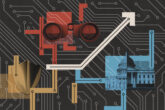February 10, 2025
How Can We Develop AI That Helps, Rather Than Harms, People?
In every technological revolution, we face a choice: build for freedom or watch as others build for control. With AI the stakes couldn’t be higher. It already mediates 20 per cent of our waking hours through smartphones, automated systems, and digital interfaces. Soon it will touch nearly every aspect of human existence. While AI promises to liberate us for higher pursuits by “extending the number of important operations which we can perform without thinking,” history – from the iron cage of Soviet bureaucracy to modern Chinese surveillance – serves as a stark warning that automation can just as easily erode our freedoms and condition us to passively accept social control.
Today’s debate about AI’s future is dominated by competing visions of control. Doomsayers, like some of those at this week’s AI Action Summit in France, advocate for strict controls (even “pauses” on all development) that would forfeit progress while inviting tyranny.
Read the full article on The Spectator.
More from CNAS
-
Technology & National Security
CNAS Insights | The Export Control Loophole Fueling China's Chip ProductionThis week, Reuters reported that China has apparently built a prototype of an extreme ultraviolet lithography (EUV) system, a highly intricate machine used to produce cutting-...
By Michelle Nie, Autumn Dorsey & Janet Egan
-
Energy, Economics & Security / Technology & National Security
Recommendations for Promoting American AI AbroadStrategic Context and Program Objectives The American AI Exports Program is an ambitious and essential proposal to expand the reach of American AI technologies in foreign mar...
By Janet Egan, Geoffrey Gertz, Daniel Remler & Ruby Scanlon
-
Technology & National Security
Prepared, Not ParalyzedExecutive Summary The Trump administration has embraced a pro-innovation approach to artificial intelligence (AI) policy. Its AI Action Plan, released July 2025, underscores t...
By Janet Egan, Spencer Michaels & Caleb Withers
-
Indo-Pacific Security / Energy, Economics & Security / Technology & National Security
Selling AI Chips Won’t Keep China Hooked on U.S. TechnologyU.S. policy should not rest on the illusion that selling chips can trap China inside the American tech ecosystem....
By Janet Egan




